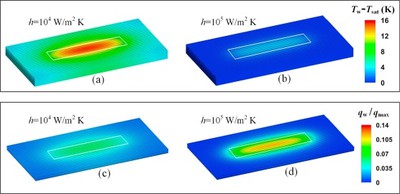Pos:
Home KnowledgeTechnologyA diamond wafer made microchannel heat sink for high-density heat flux dissipationCurrently, the miniaturization and integration of electronic devices pose new challenges in thermal management. Hotspots have become a critical thermal characteristic of current high power-density electronics, such as central processing units, laser dioxides and insulated gate bipolar transistors, in which the hotspot heat flux can reach 1000W/cm2 or higher. Deficient heat dissipation under such a high heat flux will cause excessively high temperature increases, which degrades the device performance and accelerates device failure. For high-flux heat dissipation, single/two-phase flow in microchannels, jet impingement, and spray cooling are the most efficient cooling strategies . Agostini et al performed an extensive literature review comparing various cooling technologies and referred microchannel flow boiling as the most promising technology for high-flux heat dissipation at the moment.
Flow boiling in microchannels is a promising technique for cooling high power-density electronic devices. In this study, a microchannel heat sink using ammonia as working fluid is developed, and its cooling efficiency is experimentally investigated under nonuniform high-density heat flux, which well simulates a practical heat dissipation scenario for microthermal systems. Diamond with high thermal conductivity of 1500W/m·K is selected as the microchannel heat sink material. A total of 37 parallel triangular microchannels with aspect ratio of 5, channel length of 45mm and hydraulic diameter of 280μm are uniformly engineered on the diamond film by laser ablation processing. The significance of diamond substrate as a heat spreader to minimize the nonuniformity of heat flux imposed by a central hotspot is verified. The influences of heat flux and mass flux on the cooling efficiency are experimentally investigated. An optimal range of outlet vapor quality from 0.10 to 0.13 is found, within which the minimum heat source temperature can be achieved. Notably, the microchannel heat sink is capable of managing a central hotspot with heat flux of 267W/cm2 while maintaining the heat source temperature at 53.3°C for a mass flux of 320kg/m2s.

Fig. 1. Shape of the microchannels from (a) top view and (b) cross-section view.
For flow evaporation in microchannels, the heat transfer coefficient h is usually at the magnitude of 104–105W/m2K. We hence prescribe two different heat transfer coefficients of 104 and 105W/m2K, respectively, to see how the heat transfer in the diamond substrate is influenced. The steady solutions are shown in Fig. 2. Fig. 2(a) and (b) suggest the substrate can be cooled more effectively with increasing the heat transfer coefficient. The peak temperature always appears at the middle regions where the heat load is directly imposed. The ratio of the wall heat flux at the channel surface relative to the maximum imposed heat flux underneath the heat sink, are presented in Fig. 2(c) and (d). It can be seen that the heat flux is remarkably redistributed when it is conducted to the surface of channel-walls due to the transverse wall conduction. Owning to this redistribution effect, the heat flux on the channel wall is greatly reduced down to less than 14% of the maximum imposed heat flux q max. It is this significant heat flux redistribution effect that leads to dramatic reduction of peak temperature in the solid. With increase of the heat transfer coefficient, the redistribution effect would be less significant because of the decrease of the convective heat resistance.

Fig. 2. The influence of wall conduction on the heat flux redistribution.
The white wireframe indicates the region, underneath of which the heat load is imposed. (a) and (b) show the temperature distribution in the diamond substrate. (c) and (d) show the heat flux over the surface of the channel walls.
In subject to localized heat flux as high as 267W/cm2, favorable cooling performance is achieved. The high efficiency is attribute to two aspects of the design. Firstly, the diamond substrate could spread the heat flux transversely, and consequently, the heat flux at the channel wall is dramatically relaxed to a very low level. Secondly, the convective boiling of the ammonia has a relative high heat transfer coefficient at the microchannel walls, enabling the heat flux removed effectively. These combined effects promote the cooling capacity of the heat sink dramatically, which are promising to manage even higher heat load.
CSMH focuses on the R&D and production of diamond wafers, and has created an efficient and precise machining method for diamond atomic-level surfaces based on plasma-assisted polishing, diamond wafer Ra<1nm, diamond heat sink thermal conductivity 1000-2000W/m.k, and GaN on diamond, Diamond on GaN, diamond-based aluminum nitride and other products. We will continue to innovate in science and technology, strive to be the driver and contributor of technological progress, and let cutting-edge technologies help devices break through the shackles of "heat dissipation" to achieve a leap in performance.
 闽ICP备2021005558号-1
闽ICP备2021005558号-1Leave A Message